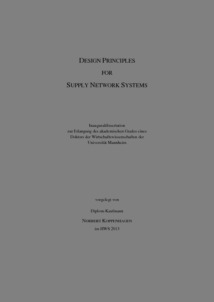|
Design principles for supply network systems
Koppenhagen, Norbert
![[img]](https://madoc.bib.uni-mannheim.de/style/images/fileicons/application_pdf.png)  Vorschau |
|
PDF (Dissertation Norbert Koppenhagen)
Dissertation_Norbert-Koppenhagen.pdf
- Veröffentlichte Version
Download (8MB)
|
|
URL:
|
https://madoc.bib.uni-mannheim.de/35382
|
|
URN:
|
urn:nbn:de:bsz:180-madoc-353828
|
|
Dokumenttyp:
|
Dissertation
|
|
Erscheinungsjahr:
|
2013
|
|
Ort der Veröffentlichung:
|
Mannheim
|
|
Hochschule:
|
Universität Mannheim
|
|
Gutachter:
|
Mädche, Alexander
|
|
Datum der mündl. Prüfung:
|
13 Dezember 2013
|
|
Sprache der Veröffentlichung:
|
Englisch
|
|
Einrichtung:
|
Fakultät für Betriebswirtschaftslehre > Wirtschaftsinformatik IV (Mädche 2009-2015)
|
|
Fachgebiet:
|
004 Informatik
330 Wirtschaft
|
|
Normierte Schlagwörter (SWD):
|
Supply Chain Management
|
|
Freie Schlagwörter (Englisch):
|
Supply Networks , Supply Management , Procurement , Business Networks , Design Science Research
|
|
Abstract:
|
Supply networks crossing organizational boundaries become more and more critical for success in the dynamics of supply relationships. The ability to quickly find, connect and qualify business partners as sources of supply on a regional, national and international basis, and to sustain those relationships crossing intercultural barriers along the completion of business cases, is and will remain a key competitive differentiator in the global economy.
Supply networks in particular are characterized by wide inter-organizational settings of connected entities, with the key focus on supply management and procurement in the provision of goods and services. As such, they describe the value generation flow between connected business partners.
Supporting supply networks on an individual company level, the primary target of enterprise resource planning systems is to standardize structured data and to streamline business processes within a company. Extending this scope, e-procurement and supplier-relationship management systems focus on supply networks beyond the boundary of a single company. They enable integration across companies by establishing standards for document exchange between different systems. However, these approaches still result in costly, rigid, and complex data and process integration of peer-to-peer nodes in dynamic supply networks.
Also, the emergence of e-marketplaces in the early 2000s could not overcome these challenges, and many of the most promising e-marketplace providers and concepts disappeared when the .com-bubble burst – primarily because of the data and process integration complexity that arises when connecting dyadic and many-to-many network relationships on a single platform.
Besides this integration challenge, e-procurement and supplier-relationship management systems are targeted on streamlining structured business processes and handling of structured data. Structured data and processes have fixed coded meaning, format and sequence - from start to completion of a business transaction. Structured data is normally stored in database fields, and structured processes follow pre-defined patterns of transactional steps to complete standardized business cases. The coverage of structure data and processes is mostly sufficient where the use case is commonly defined and accepted by the involved business partners, composed mostly of routine steps and not requiring much direct human interaction.
To cope with the increasing challenges in the highly collaborative, inter-organizational settings and to leverage Web 2.0 and Enterprise 2.0 capabilities in supply networks, the support of unstructured interactions become more important. Unlike structured data and processes, unstructured interactions like instant messages, feeds, or blogs have no or limited fixed format, are directly derived from human interactions resulting in textual data, and can hardly be computed without any prior transformation. Many of these happen before, during, and after the actual execution of structured business processes, but are rarely supported by the corresponding supply management systems. This is a particular challenge, as Cappuccio (2012) predicts that enterprise data will grow by 650% over the next five years, with 80% of that data being unstructured.
In summary, by designing systems providing utility for companies and business professionals in supply networks, the two comprehensive challenges of (1) data and process integration and (2) support of unstructured interactions need to be addressed.
Addressing these challenges, the doctoral thesis proposes a design that tightly bundles both structured and unstructured data and process perspectives - following suggestions “[to find] new ways to generate and maintain connections within and between social units, and new social connection-focused IT capabilities” (Oinas-Kukkonen et al. 2010, p. 61). Through not looking at both challenges independently, the overarching research question is:
Which design principles instantiated in a software artifact advance supply networks for professionals, by connecting both structured and unstructured data and processes?
The answer to this research question consists of aggregated design principles for the design and implementation of supply network systems supporting business professionals in supply management and procurement. Their individual performance in supply networks should increase, and their effort to execute supply network tasks should decrease, assuming that improvements at individual levels will also lead to supply network advances overall.
In order to answer the research question, Action Design Research (ADR) is employed, based on the Design Science Research (DSR) paradigm.
The design principles of ‘networked business objects (n-BO)’ and ‘social augmentation’ are conceptualized, which are used to derive and implement related design decisions in a software artifact. Finally, testable hypotheses are derived and evaluated towards the utility of both the artifact and the underlying design principles.
|
 | Dieser Eintrag ist Teil der Universitätsbibliographie. |
 | Das Dokument wird vom Publikationsserver der Universitätsbibliothek Mannheim bereitgestellt. |
 Suche Autoren in Suche Autoren in
Sie haben einen Fehler gefunden? Teilen Sie uns Ihren Korrekturwunsch bitte hier mit: E-Mail
Actions (login required)
 |
Eintrag anzeigen |
|
